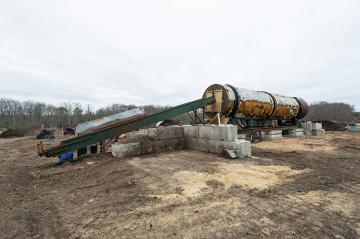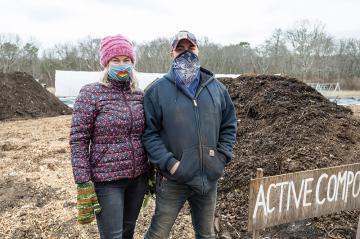A foodstuff waste recovery undertaking started 4 years ago on the Winery is ramping up again just after the pandemic interrupted the bulk of the collections.

Giant contraption turns tons of food items squander into compost.
— Ray Ewing
When eating places and college cafeterias closed previous year, the Martha’s Winery Food Waste Recovery Initiative misplaced the most important resource of the foods scraps it turns into compost at Island Grown Initiative’s Thimble Farm.
Volumes dropped dramatically, task director Eunice Youmans instructed the Gazette in a latest interview.
“We experienced planned to gather 540 tons in 2020. We ended up gathering 200 tons,” she claimed.
Begun in 2016 as a pilot task with a borrowed pickup truck, 7 enterprises and a grant from the Betsy and Jesse Fink family members basis, the initiative established an formidable target of decreasing meals squander on the Winery by 50 for every cent by 2030.
The undertaking immediately expanded. In the first 12 months, 17 tons of food items squander ended up processed. Two many years later on the selection was 360 tons.
And when very last year’s full was significantly less than 50 percent the pre-pandemic aim, it represented a substantial improve in domestic participation — from five per cent in 2019 to 25 for every cent in 2020, Ms. Youmans mentioned.
“That’s a substantial change in the share of our resources of squander, but nonetheless only a portion of household food items squander,” she stated. Nationwide, 43 per cent of foodstuff squander will come from households, Ms. Youmans reported.
Right now the foodstuff squander undertaking has collection barrels at all Island transfer stations, as properly as at the Chappy Place ferry landing and outdoors the gate at Thimble Farm. There is a little fee to fall the squander at transfer stations the dropoff at the farm is free of charge.
IGI contracts with Bruno’s Roll-Off to acquire the food stuff waste from the landfills and choose it to Thimble Farm. There the scraps are fed to the farm’s significant flock of chickens and converted to nutrient-prosperous, backyard garden-prepared compost in a railroad-auto-sized contraption.
In previously a long time, Island Developed marketed the compost, discovering a prepared market.
“We collected 160 tons of foodstuff waste in 2018, and sold 160 tons of compost in 2019,” Ms. Youmans said.
Final calendar year was a different story. As the pandemic lockdown pressured far more Island people into foodstuff insecurity, Island Grown shifted its endeavours to rising a lot more food stuff at Thimble Farm, generating an in-dwelling desire for compost.

Job leaders Eunice Youmans and Mark Letourneau.
— Ray Ewing
“What we generally bought, we finished up diverting to regenerative agriculture,” Ms. Youmans mentioned.
Nevertheless, she explained, earlier compost product sales have proved that food stuff squander restoration is a feasible company on the Vineyard.
“There’s a market place for foods squander selection,” she claimed. “There’s a market place for compost gross sales.”
A legislation enacted by the Massachusetts Section of Environmental Security in 2015 prohibits any corporation that creates a ton or far more of food items waste for each week from disposing of it as trash.
The threshold will fall to 50 percent a ton in 2022, according to Ms. Youmans.
“You have an inherent need for foods waste recycling infrastructure,” she said.
There is no comparable statewide regulation implementing to household food waste, but Ms. Youmans hailed a latest conclusion by the town of Hamilton to involve composting as a issue of residential trash collection.
“I think it’s fantastic,” she explained. “Now we have a model. Hamilton has showed us you can really do it by means of your decide on board. I consider which is anything we really should go after, lobbying our select boards to mandate food stuff waste separation.”
With early indications of a busy Winery time in 2021, Ms. Youmans mentioned she has large hopes for this year’s haul from homes and organizations alike.
“My formal purpose is 360 tons [the amount collected in 2019] but I feel we can do 500 tons this year,” she mentioned, also noting that food items squander signifies a sizeable source of greenhouse gases, from foodstuff manufacturing, packaging, shipping and delivery and storage to disposal and decay.
Composted soils, in the meantime, get up carbon dioxide from the atmosphere.
“It’s a double gain,” Ms. Youmans reported.
